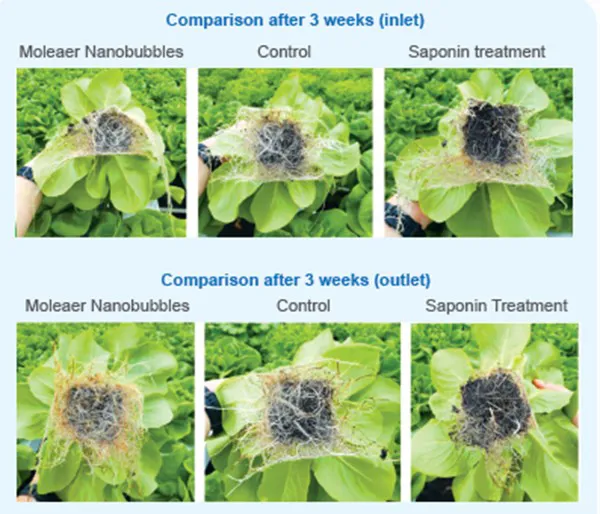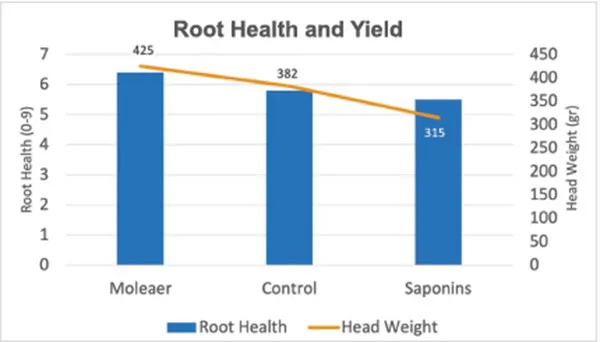In May 2023, Proefstation, a leading agricultural research center in Belgium, initiated a study to assess the effectiveness of Moleaer nanobubble technology in controlling Phytophthora cryptogea, a notorious pathogen impacting root health and development, on hydroponically grown lettuce variety Fairly. The study focused on comparing Moleaer nanobubble treatment, maintaining oxygen levels at 20 ppm, against alternative treatments and a control group with no treatment.
Anaerobic pathogens such as Phytophthora and Pythium significantly affect root development, thereby impacting crop growth and yield. Consequently, well-oxygenated water is a crucial factor for growers, particularly in hydroponic conditions. Temperature plays a vital role in the spread of these pathogens, with optimal growth observed between 25 and 30 degrees Celsius (77ºF to 86 ºF) for both Pythium and Phytophthora. Therefore, it becomes even more critical for growers to maintain good water quality when temperatures rise to control the spread of these pathogens.
A trial was conducted to compare the effect of nanobubble-enriched water with a saponin-based treatment (a plant-based compound with potential anti-pathogenic properties) and with a control with no treatment. The plants were moderately infested with Phytophthora artificially, and additional stress conditions were induced by removing roof screening to keep elevated temperatures (25 ºC or 77 ºF). Higher temperatures are directly related to the development and spread of pathogens, so the objective was to measure the impact of the treatments on stopping or reducing the infection at high temperatures and under conditions.
Nanobubbles impact root health and development, yield, and consistent growth
The roots of the plants in the section treated with nanobubble-enriched water exhibited superior health compared to both the control and the saponins treatment at the inlet and at the end of the line (see photos below).
 Lettuce irrigated with nanobubble-enriched water developed stronger and healthier roots than the control and the alternative treatment both at the inlet and at the outlet.
Lettuce irrigated with nanobubble-enriched water developed stronger and healthier roots than the control and the alternative treatment both at the inlet and at the outlet.
There were also significant differences in yield, favoring the Moleaer's nanobubble treatment. Moleaer's treatment showed a 43g (11%) increase in weight compared to the control and a remarkable 110g (35%) increase compared to the saponins treatment (Graph 1). In the treatment with nanobubbles, the average weight at the end of the gutter was the same as at the inlet, highlighting the consistent growth throughout the hydroponic system. This contrasts with the other treatments, where a slight decrease in average weight was noted for plants located at the end of the gutter.

Graph 1: Root health and head weight, a yield metric, were higher for crops irrigated with nanobubble-enriched irrigation water.
"The case study at Proefstation demonstrates the remarkable effectiveness of Moleaer nanobubble technology in promoting root health, increasing lettuce head weight, and ensuring consistent growth in hydroponically cultivated lettuce variety Fairly. These findings suggest that Moleaer technology can serve as an innovative and reliable solution for controlling Phytophthora cryptogea and improving overall crop yield in hydroponic systems," said Tinne Dockx, Researcher at Proefstation.
A previous trial conducted by Proefstation in lettuce also concluded that molester nanobubbles were the most efficient method to transfer oxygen into the water, which helped with root development and health in two different varieties. A commercial case study in the Netherlands with a strawberry grower saw a very significant reduction in Phytophthora and Pythium after enriching the irrigation water with Moleaer nanobubbles, in addition to an 11% yield increase. Researchers from Delphy Research Institute and NovaCropControl also reported reduced pathogen levels on other crops using Moleaer's nanobubble technology. Both studies also reported better root development and higher yields.
Impact of Moleaer nanobubbles on biofilm and water quality for pathogens control
In addition to aiding in the elimination of pathogens without the use of chemicals through enhanced and efficient oxygenation in both the water and the root zone, the unique characteristics of Moleaer nanobubbles, such as their hard shell and electrically charged surface, enable them to scour irrigation lines, effectively removing biofilm without the need for chemicals. These combined benefits improve the root zone conditions to support improved and healthier root development and enable reduced input costs and more efficient and sustainable operations.
For more information:
Moleaer
20800 Belshaw Avenue
Carson, California 90746 USA
Tel.: +1 (424) 558-3567
www.moleaer.com
